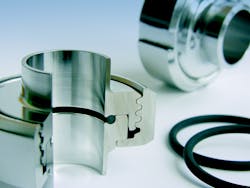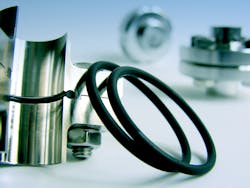Selecting the right seals for food and beverage processing
Sealing in food and beverage applications is extremely challenging. Not only must seals stand up to extreme temperatures, steam and wear in dynamic situations, but they must also meet regulatory requirements and be compatible with different food types and ingredients, such as fats, oils and acids. In addition, hygienic design, resistance to aggressive cleaning regimes and avoidance of flavor carryover are top priorities.
This article discusses seal materials used in food and beverage processing applications, the use cases for each, and common factors that can affect seal performance, equipment uptime and food and beverage product performance, as well as the benefits of partnering with an experienced seal manufacturer to ensure the sealing solution best meets the requirements of the application.
Seal materials used in food and beverage applications
One of the keys to prolonging the life of seals used in food and beverage applications is matching the material to its processing system or the processing system it is used in. The seals must be resistant to the foods and beverages processed, as well as the chemicals used in cleaning regimes, often at elevated temperatures.
One of the most commonly used materials for O-rings and gaskets in food and beverage processing is ethylene propylene diene rubber (EPDM), a fully saturated, non-polar hydrocarbon-based elastomer. Its polymer geometry gives it superior compatibility with polar fluids even at elevated temperatures. EPDM demonstrates high chemical resistance, is suited for use with alkaline and acidic cleaners, and is an excellent choice in most dairy applications, except for products with high fat content. Its typical applications are filling, dispensing, pumps, pipe and flange gaskets, valves and quick connectors.
For applications using animal and vegetable fats and oils, acrylonitrile-butadiene rubber (NBR) is a good choice when the O-rings will not be exposed to harsh cleaning regimes, ozone or superheated steam. NBR is a copolymer of butadiene and acrylonitrile, and the percentage of these in the NBR formulation determines the performance characteristics of the material.
Fluoroelastomer (FKM) materials are optimized for steam environments in the food and beverage industry. They demonstrate good suitability for use in contact with vegetable oil and fat, animal fat and high-fat dairy products. They also have good resistance to ozone and aging.
The gold standard for elastomer sealing, perfluoroelastomer (FFKM) is more expensive than other sealing materials but is compatible with virtually all media. It is ideal for extremely aggressive processing and cleaning regimes in which seals can deteriorate very quickly. Though more expensive, FFKM seals can extend planned maintenance and, therefore, lower the total cost of ownership substantially.
Silicone materials are ideal for use in food and beverage production due to their inherent inertness to growth of bacteria, mold and fungi. Silicone has excellent heat resistance, cold flexibility and dielectric properties and is the preferred choice in applications exposed to ozone and oxygen. Injection molded silicone components lend themselves to complex geometries that offer product designers more options, especially when combined with metals and plastics using multicomponent technology. Multicomponent technology enables several parts in an assembly to be combined into a single component, preventing dead space in which bacteria can grow.
Polytetrafluoroethylene (PTFE) seals offer a wider service range than elastomeric seals when it comes to temperature, pressure, dynamic sealing against moving surfacing in shafts, and the vast array of media that seals encounter. PTFE is an inert material that makes it resistant to nearly all chemicals and acids. In particular, it demonstrates outstanding low-friction characteristics, minimizing wear. This makes it ideal for dynamic applications such as mixers or closing pumps.
As PTFE has limited elasticity, PTFE seals are usually energized with an elastomer O-ring or a spring. In food and beverage applications, the elastomer must be compatible with process and cleaning media. Springs can, depending on their position within a processing system, be encapsulated to avoid dead space.
Engineered plastic-based materials, such as polyetheretherketone (PEEK) and ultra-high molecular weight polyethylene (UHMWPE), are ideal for reciprocating and oscillating equipment that requires high wear resistance and may encounter abrasive media and countersurfaces. These materials are ideal for a variety of food processing applications, such as filling machines, valves, pumps, mixers, separators, homogenizers, centrifuges, dosage cylinders and sensors.
Extending seal life
Selecting the right seal material for the application is critical to ensure seal life and to extend the period between planned maintenance. Seal failure can lead to potential contamination or even line stoppages. Therefore, materials, whether elastomers or plastics, must cope with a broad variety of food types, as well as clean-in-place (CIP) and sterilization-in-place (SIP) processes.
Automated CIP and SIP processes are currently the best methods for cleaning processing systems. They ensure safety and efficiency, prevent microbiological contamination of the food, and minimize recontamination of the process equipment. However, aggressive chemicals used in cleaners can rapidly cause severe damage to elastomeric seals, especially in applications with load and pressures. With high temperatures and steam sterilization, which is now commonly up to 302°F, this deterioration is intensified.
When specifying seals, it is, therefore, important to recognize the sealing conditions within the processing environment and to select specialty seals that are tested and proven to be compatible with the system’s operating parameters.
Matching the seal material to the food or beverage ingredients and the cleaning chemicals can maximize the interval between planned maintenance and production yield. With the details of a processor’s specific requirements, specialized seal manufacturers can propose cost-effective solutions that are compliant with all major standards and proven to stand up to cleaning regimes, however stringent.
Improving friction characteristics
Elastomers have a high coefficient of friction, meaning they tend to stick either to each other during automated assembly or to mating surfaces when inserted into a housing. Coating technology improves the friction characteristics of elastomer seals, enhances wear resistance, and lowers insertion forces.
For food and beverage processes, the coating must meet the same regulations and standards as the seal. It is also critical that the coating does not deteriorate and flake off the seal. Specialized alternative treatments that improve friction characteristics avoid this issue.
Hygienic design
Gaskets, seals and rough pipe and equipment surfaces are potential bacteria havens and create hygienic challenges for the food and beverage processing industry. The solution is hygienic design. Close collaboration between the food and beverage equipment manufacturer and the seal supplier is required during the initial design stage to ensure that hygienic design options are maximized. One of the best ways to achieve hygienic design is by utilizing multicomponent technology in which several parts are combined into one component to eradicate dead space. Working with experts in this field requires a holistic engineering approach that not only looks at the seal but also its housing and counterparts.
An unsavory situation
Flavor carryover, an unsavory issue in food and beverage processing, has been made more challenging by the beverage industry’s trend toward increasingly intense flavors. Beverages with high concentrations of flavors naturally tend to leave perceptible traces of aroma in the bottling lines. Despite cleaning measures and adapted production plans, small traces of aroma can remain in the bottling machines, which can then be absorbed by the next beverage.
The elastomer materials used in filling machine sealing components that come in contact with beverages have proven to be a significant factor. The aromas used for beverages, especially when used in high concentrations, diffuse into elastomer materials. The seals can then release the absorbed aromas even after thorough rinsing between beverage filling processes. The consequences of flavor carryover are wasteful transitions from one product to another, product rejects, unintentional downtime, additional inspections, and complaints.
Case study
Krones, a specialist in beverage bottling, partnered with Trelleborg Sealing Solutions to analyze the reasons behind unintentional flavor carryover during the filling process. The companies found elastomer sealing components to be a relevant factor in aroma carryover. They determined that selecting the optimum sealing material is crucial to preventing the transfer of flavors from one filling process to the next.
They also proved that FKM and FFKM materials demonstrate effectiveness when it comes to preventing flavor and aroma carryover. FFKM materials do not absorb aromas and show virtually no detectable effect on the taste of subsequent beverages, even under unfavorable conditions. This makes these sealing materials ideal for use on bottling lines that are processing beverages with intense flavors. Analysis of sealing materials showed that aroma absorption was higher for FPDM than for FKM materials, which demonstrated significantly better performance, making it suitable for use with many beverages.
Sealed to standards
In addition to addressing the many factors affecting processing equipment, sealing materials must also meet regulatory requirements for food contact materials. These regulations are especially important to food and beverage equipment producers who sell their products globally. In particular, the requirements in the international food processing industry are in focus. They include the well-established EU Food Contact Regulations and the U.S. Food and Drug Administration (FDA) regulations, as well as recent Chinese Food Regulation certification in the Chinese food equipment market.
Looking to the future
More than ever, companies are seeking to increase the safety of their machines and applications, while at the same time, aiming to reduce maintenance and the cost of unexpected downtime. Numerous sensing solutions, coupled with the internet of things (IoT), are becoming economically viable solutions in advanced seal management and allow for the remote monitoring of devices and data collection.
As seals are often critical components within processing systems, artificial intelligence (AI) can offer real benefits to manufacturers. From sensor selection to data analytics, sealing manufacturers can collaborate with equipment manufacturers to develop predictive failure models, build system health dashboards and improve system operation.
Conclusion
Sealing solutions are critical to the performance of processing equipment and can have a significant impact on the commercial success of food and beverage products. Partnering with an experienced seal manufacturer can help ensure the best sealing material and design is selected to address the many factors affecting processing equipment performance, including the chemicals with which the seals come in contact, mechanical properties, CIP and SIP regimes, aroma carryover, hygienic design and the need to comply with industry standards and regulations.
David Kaley started his career in the food industry, working in an engineering lab developing and testing automation equipment for use on the manufacturing and packaging floor. Later, he took on a product management role where he developed products for food and beverage customers. As Trelleborg’s business development manager, Kaley understands what customers need to satisfy regulatory demands across the globe, and he is focused on helping customers succeed in the food and beverage industry.
Trelleborg Sealing Solutions


